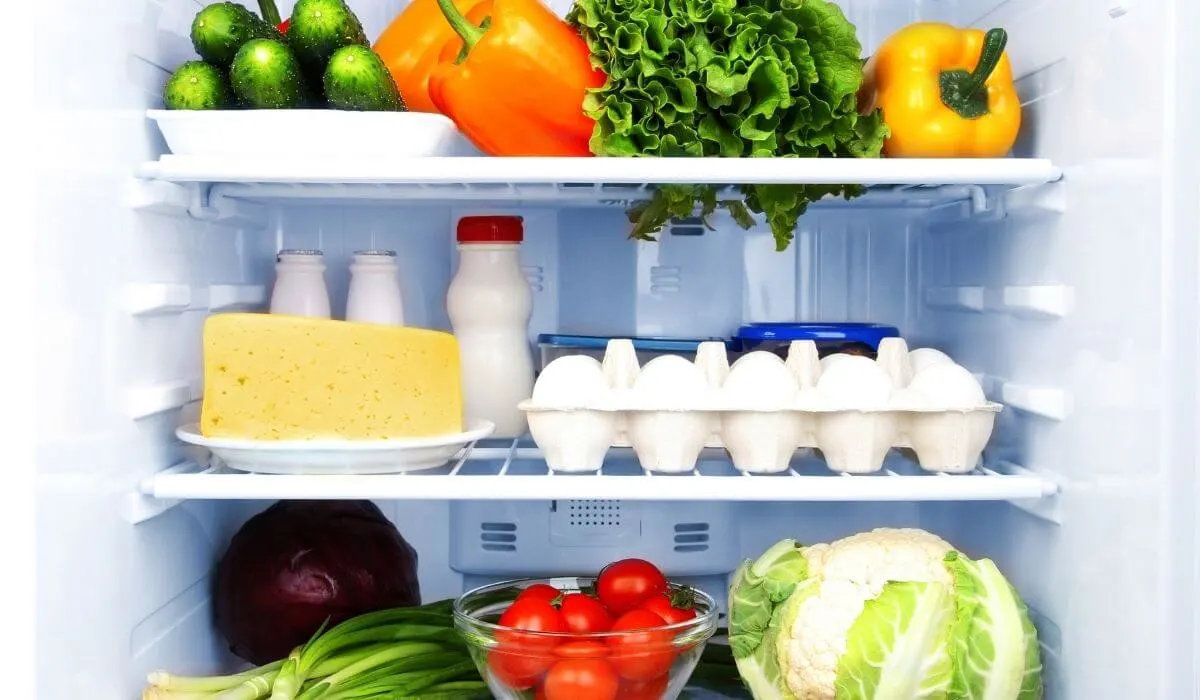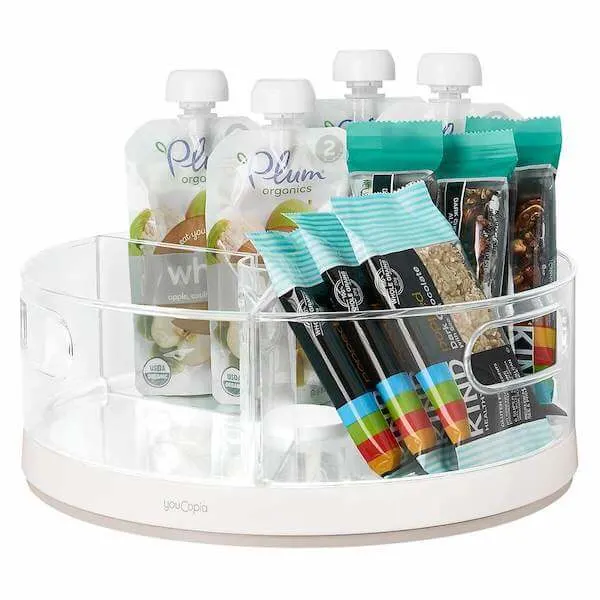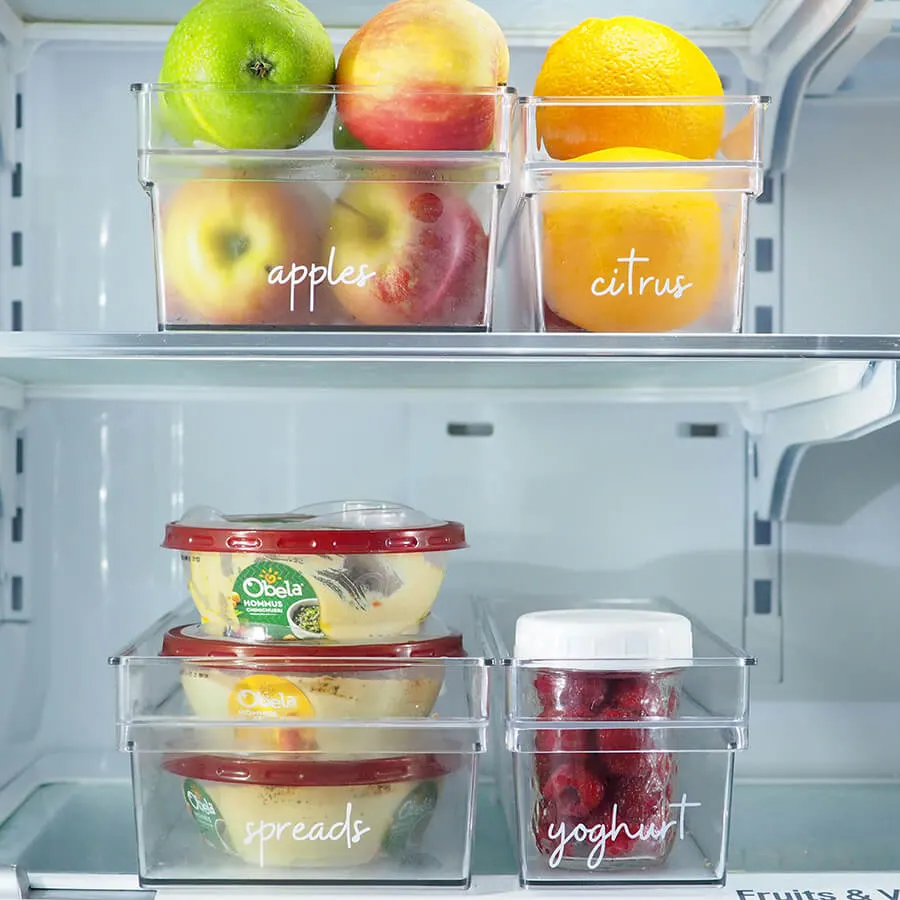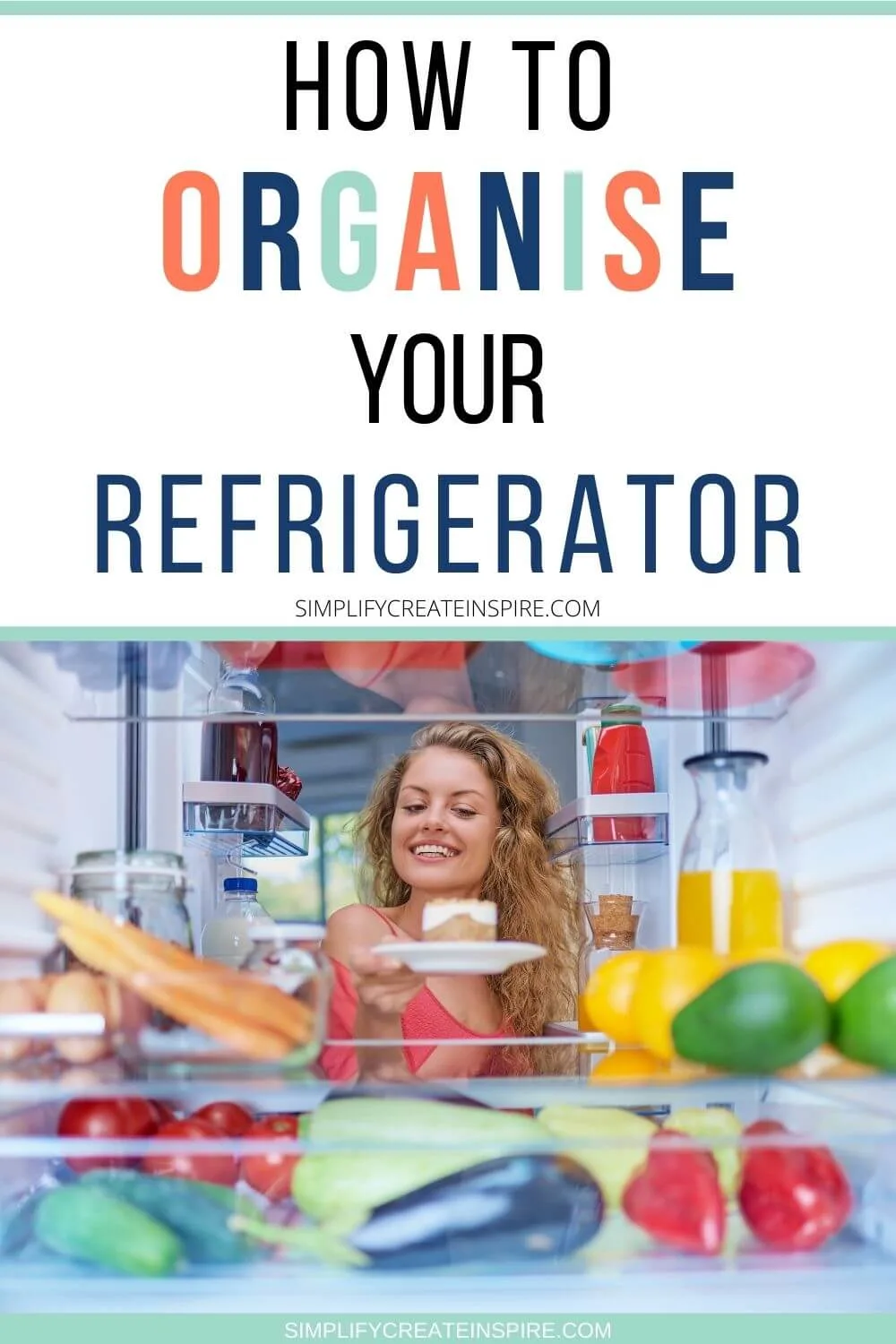Sick of having a cluttered and disorganised refrigerator? These fridge organisation tips will help you turn your chaos into calm in no time. Learn how to organise your refrigerator easily with simple storage systems that even the busiest household will be able to maintain!
Make sure you also check out these genius pantry organisation ideas and grab the free pantry staples checklist for stocking your pantry.

How To Organise Your Refrigerator
It’s no secret that fridge organisation can be a real hassle. I mean, there are so many different shelves and compartments to work with!
Just when you think that you have found the perfect place for everything, it turns out that your tomatoes don’t fit anymore because they’re too big…or you just discovered a soggy vegetable at the back of the fridge that was long forgotten.
It doesn’t matter how good your intentions are if you don’t have a system that works in keeping an organised fridge!
This typically leads to forgotten and wasted food, which = wasted money!
Well, worry no more as these life-changing fridge organisation tips will help you get the most important appliance in your kitchen sorted once and for all!
Fridge Organisation Basics
Once your fridge is organised and the food has its own spot, you’ll be able to find what you need in a matter of seconds. You will also save money!
It will make cooking much easier when everything is within arm’s reach with easy access to items you use most often.
The key is to utilise your fridge storage system the moment you arrive home after the grocery store too, or else you will end up with the same issue in no time!
An organised fridge means less food waste!
To organise your refrigerator, here is a basic guide on where to best store the different food groups and items on your fridge shelves and drawers:

- Upper Shelves – The top shelves are the best place to store items that don’t require cooking, such as cold deli meats, sealed leftovers and anything that you use often and want in easy reach.
- Middle Shelves – The middle shelf has the most consistent temperatures in your refrigerator, making it perfectly suited to dairy products such as cheese, butter, eggs, yogurts, cream cheese and milk.
- Bottom Shelves – As the bottom shelf of the refrigerator tends to be the coldest part of the fridge, this is the ideal zone to store raw meat and seafood. Storing them on the lower shelves of the refrigerator reduces the risk of contamination from leaks.
- Fridge Drawers – The crisper drawers, located under the bottom shelf of the fridge, are designed to keep fruit and vegetables fresh for longer. Don’t be tempted to mix these items as the two drawers are designed to suit the type of product they are made for. This means low humidity for the fruit drawer to slow rot and higher humidity for vegetables to minimise excess moisture. Drawer storage also reduces the likelihood of these items freezing from sitting against the back of the fridge, making it a good place to store sealed salads, leafy greens and herbs as well.
- Fridge Doors – The fridge door shelves tend to be the warmest part of the fridge, with temperature fluctuations, due to the refrigerator doors being opened and closed. This area is best to store condiments, salad dressings, sauces and vinegar that don’t require the coldest temperatures.
Food Safety Tips
The refrigerator is no place for risky behaviour! These food safety and storage tips will help keep you and your family healthy and minimise the risk of food poisoning and illness:
- Keep your fridge clean with frequent wipe-downs of shelves and a regular refrigerator deep clean in your cleaning schedule.
- It is best to keep raw and cooked foods separate from each other. Place all ready-to-eat items on the top shelf, always higher than any food you are cooking in order to avoid contaminating your dishes with anything that might drip or fall into them.
- Be sure to keep your fresh produce, such as salads and herbs away from the back of the fridge. These delicate fresh foods can freeze or go bad if they get too cold. The very back of a refrigerator is colder than anywhere else.
- Cooked foods need to be covered with a lid, foil or plastic wrap. Raw meat and seafood need an airtight seal so they don’t spoil. This also helps prevent leakage and contamination of other foods in your refrigerator.
- Keep condiments and open jars in the refrigerator once opened, or consider transferring to a storage container.
- Avoid storing hot food in the refrigerator. This can lead to your overall temperature rising, which could cause potential illness and spoilage of other items in the refrigerator.
How To Clean Your Refrigerator

There is no point organising your refrigerator if you don’t first start with a clean canvas! Give your refrigerator a deep clean and make this a regular part of your home cleaning schedule.
To clean your refrigerator, start by removing all the shelves and drawers. Clean each removable part of the fridge with hot water and mild dish soap. Dry thoroughly.
Wipe down the inside of your refrigerator with a damp cloth. For any tough food spills, you can use a food-safe antibacterial cleaner.
Alternatively, if you’re looking for DIY cleaning solutions, make up a spray bottle that is 1 part vinegar, 3 parts hot water and spray this inside your refrigerator. Wipe down with your cloth to remove all spills and dirt.
Follow with a wipe-down using a dry cloth or paper towels. Put refrigerator shelves and drawers back in place.

Preparing To Organise Your Refrigerator
Efficient storage is the key to a happy kitchen. But that doesn’t mean you need to rush out to the store and stock up on storage containers right this second. You need to make sure you’re buying the right kind of fridge storage that will work for you!
The first thing you’ll want to do is separate your food into groups that will make your fridge more organised and easier to find what you’re looking for.
You also need to think about how often and where you use certain foods so that you can group them by frequency of access.
Some people like to organise their refrigerator with specific food groups, which is also a good idea if that’s how you think
How you prepare your food also plays a role. While you may be ready to create new habits with food prep and storage, typically the most successful fridge organisation is a system that simply makes your current habits easier!
Do you keep everything in original packaging or do you prefer to transfer items to storage containers?
Do you meal prep in advance and store leftovers in the fridge, or do you prefer to make meals fresh throughout the week?
Once you’ve answered these questions and assigned a group of foods to each shelf, it will be much easier to find what you’re looking for and to plan how you want to organise them.
The Best Fridge Storage Ideas
Choosing the right storage containers for your refrigerator will depend on your needs.
If you want containers that you can use to store raw ingredients, and chopped fruit and vegetables, you want storage containers with lids.
Using containers inside your fridge will also help keep it clean!
Glass Storage Containers – Clear glass jars and glass containers with lids allow you to see what is inside without opening them. They are also great for storing liquids or raw food, such as meat and fish since glass won’t stain or discolour. Containers with lids also seal tightly to keep moisture out to help keep foods fresh longer.
Stackable Fridge Containers – If you want the most space possible, stackable containers are a great idea. These can be either plastic containers or glass. Stackable containers are great for storing smaller items or meal prep ingredients since they can be stacked to save space.
Storage Tubs – These containers are a great option for storing similar items or bulk items. Plastic bins can also be used in the fridge to store things like cheese, individual yogurt tubs, chilled snacks or cans since the tub keeps them all together easily.
Lazy Susan – If you don’t have enough room on your refrigerator door shelves for all your condiments and jars, a lazy Susan is a great option. Set one up on the top shelf for easy reach and rotate it to reach the items at the back of the tray. Total game-changer!

Container Store turntable – Find it at The Container Store
Hanging Shelf Baskets – Utilise vertical space by adding hanging or clip-on baskets to your shelves. This creates new storage in the vertical space area that might otherwise have been wasted space.
Tray – A tray on the bottom shelf of your refrigerator is a great option for uncooked meat and seafood to reduce the chance of leaking. It is also a good option for defrosting frozen food in the fridge.
Fridge Snack Station – A favourite hack we have for younger family members in our home is setting up a refrigerator snack station with snack food items in easy reach. This is a great way to encourage kids to choose healthy snacks and also to put items that need to be used soon due to expiration date.
Refrigerator Labels
Labelling your food storage containers and tubs will save you time later on because when you come to use what is inside, you’ll know exactly what is in each.
Labels are also a great option if you prefer to ditch original packaging on sauces, condiments and jar or tinned goods, ensuring you know what is in each container without having to guess or smell it.
No more mysteries!
The best labels to use are plastic adhesive labels, as paper labels may not hold up to the moisture within your refrigerator.

The fridge is one of the most used appliances in your home. It stores the essentials to make a delicious meal, and it should be treated as such!
You don’t want items buried under others or lost at the back, so put these fridge organisation ideas into action with these clever ideas for organising your refrigerator space to ensure everything has its place. The key is to get creative and find what works best for you.
This will help not only keep your food organised but also reduce the amount of food waste as well!
What are some of YOUR favourite fridge organisation ideas? Share them with us below.
You might also like these tips for home organisation:
- Meal planning for beginners
- How to create a cleaning schedule that works
- How to deep clean your entire home
- Declutter your home without feeling overwhelmed
- 30-Day decluttering challenge
- Tips to simplify your before school routine
- Ways to reduce cleaning time at home
- How to organise paperwork in your home
- Party organisation tips
- How to create a home management binder
- Ways you can simplify your life and improve wellbeing
- Ideas for a home command center




















